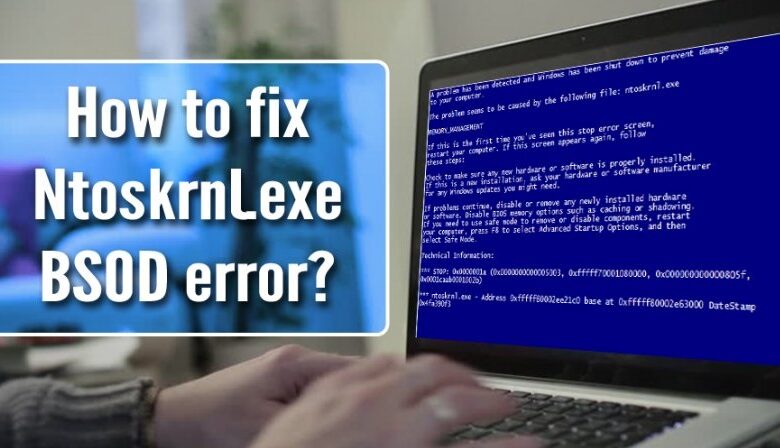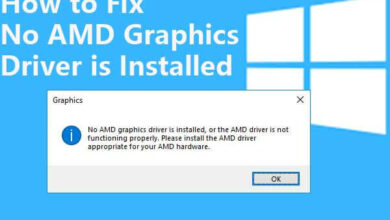*Fixed* Ntoskrnl.exe BSOD Blue Screen Error

You have found a Blue Screen of Death that points towards Ntoskrnl.exe as the culprit. Before it got to this, you probably saw the following symptoms:
- – Sluggish P.C. efficiency.
- – High CPU use and subsequent overheating.
- – Random System reboots.
Lastly, throughout system boot, you get a mistake message saying “ntoskrnl.exe file is missing out on.”
*Fixed* Ntoskrnl.exe BSOD Blue Screen Error
In this article, you can know about ntoskrnl.exe here are the details below;
Do not get fretted much. It’s not a problem that cannot be dealt with. So please keep checking out to discover how to get rid of the Ntoskrnl.exe BSOD.
What Causes the Ntoskrnl.exe Error?
No one thing could be said to be the cause. The concern could be software application- or hardware-related. However, the possible factors consist of.
1. Your device drivers are obsoleted, corrupt, or incompatible. This is why it is essentials to ensure you keep them routinely updated.
2. Malfunctioning RAM. Changing the sticks need to fix the issue.
3. Your RAM and regional storage might be inadequate in keeping up with the activities you carry out on your computer system. This causes regular freezing, and subsequently to the Ntoskrnl.exe mistake.
4. You overclocked your devices.
5. A few of your system files are corrupt.
What Is Ntoskrnl.exe?
Ntoskrnl.exe error (brief for Windows NT running system kernel) is a vital Windows part responsible for hardware abstraction, process and memory management, and numerous other system services.
It consists of:
- – Cache supervisor
- – Kernel.
- – Memory supervisor.
- – Executive.
- – Security recommendation screen.
- – Scheduler (Dispatcher).
Since it’s an essential part of Windows, your computer system crashes and shows a BSOD when it experiences a problem. The issue might happen repeatedly. You might also get a ‘Memory management’ error code.
Now that we’ve seen the possibles causes, let’s go on and present the solutions.
1. Update your chauffeurs.
2. Run a scan with the Window’s Memory Diagnostic Tool.
3. Run the System Files Checker (SFC)/ CHKDSK scan.
4. Reset overclocking settings for your gadgets.
5. Set up Windows updates.
6. Perform a system bring back.
7. Indicate your hardware.
You can perform these fixes sequentially and randomly, according to your discretion.
Let’s start.
Fix 1: Run a Scan with the Window’s Memory Diagnostic Tool.
The BSOD could be connected to a faulty memory (RAM) module. So here’s what you need to do.
1. Close all open windows.
2. Go to the Start menu.
3. Type ‘Window’s Memory Diagnostic’ into the search bar, and after that, click the option when it appears in the results list.
4. Click on the choice that states ‘Reboot now and look for problems (advised).’.
5. Your System will restart, and the scans will commence. Wait on it to complete. It might take a while (could be as much as an hour, depending on the size of your RAM).
6. After the scan, you will get the results once you log into your computer system.
Fix 2: Update Your Motorists.
We advise you to utilize Auslogics Chauffeur Updater to scan all out-of-date and defective motorists on your PC. It will automatically install the latest manufacturer recommended versions. The tool acknowledges your system requirements, so you don’t have to worry about downloading the incorrect drivers.
You might also perform the upgrade manually through Device Supervisor or by checking out your gadget manufacturer’s main website to look for each one of your motorists. Ensure you get the versions that work with your O.S.
Fix 3: Reset Over-clocking Settings for Your Devices.
Although overclocking is a clever method of using your hardware’s maximum ability, it can likewise lead to getting too hot, hardware breakdowns, and System Crashes. Stop overclocking your gadgets if you are experiencing the Ntoskrnl.exe error.
You can use a relied on the program to alter the settings. But you can likewise do so through BIOS/UEFI. The procedure will differ for each device. For that reason, search for the guidelines on how to get it done.
Fix 4: Run the System Files Checker (SFC)/ CHKDSK Scan.
The error could be due to depraved system data. An SFC scan will discover and repair them.
Follow these simple steps.
1. Go to the Start menu.
2. Type ‘CMD’ in the search bar and right click on Command Prompt from the search results page.
3. Select Run as manager to open an elevated Command Prompt window.
4. You will receive a User Accounts Control (UAC) confirmation dialog. Click the Yes button.
5. Copy and paste ‘SFC/ scannow’ in the windows (ensure you don’t include the inverted commas) and press Enter upon your keyboard. If you choose to type the lines, there ought to be a space between ‘SFC’ and ‘/ scannow.’.
6. Wait on the scan to complete. You will then get a reports on the repairs that were attained.
If the scan shows that some problem were unable to be fixed, run a CHKDSK scan. Heres how.
1. Press the Windows logo design secret + X combination on your keyboard to open the WinX menu.
2. Find Command Prompt (Admin) in the list and press on it. This will open an elevated Command Prompt.
3. Click the Yes button when provided with the User Account Control (UAC) verification dialog.
4. In the window thats opens, type (or copy and paste) ‘CHKDSK/ f/ r’ and push Go into (do not consist of the inverted commas).
5. You might be asked whether you want the scan to be performed when next your computer system boots up. Type ‘y’ and press get in.
6. Wait for the scan to finish.
Afterward, run the SFC scan again.
Fix 5: Install Windows Updates.
Follow these simple actions.
1. Press the Windows logo secret + I mix on your keyboard to open the Settings app.
2. Click on Update and Security.
3. Select Windows Update and after that, click the ‘Look for Updates’ button on the right-hand side of the window. If there are any offered, windows will download and install them immediately.
4. Restart your P.C. and then see if the problem has been dealt with.
Fix 6: Perform a System Restore.
The System brings back will take your O.S. back to a time when no concerns existed. Follow these all easy steps to get it done.
1. Conjure up the Run dialog by pressing the Windows logo design key + R combination on your keyboard.
2. Type CPL in the text field and press Get in or click OK.
3. Go to the System Protection tab, and after that click, the System Bring back … button.
4. In the window’s that opens, click ‘Next’ and pick a restore point.
5. Follow the instructions showed on the screens to finish the procedure.
Fix 7: Check Your Hardware.
A failing RAM modules or Solid State Drive (SSD) could be the cause of the error you are handling. Change your hard sticks and see if the concern will be solved.
We recommend you check out a specialist to help you perform this fix. If you have 2 RAM slots, you can attempt to get rid of both sticks. Tidy the slots, and reinsert one stick. See if that fixes the concern. If no, reinsert and try once again.
If your Windows O.S. is set up on your SSD, reinstalling it ought to fix the problem. We hope these solutions have been of helps to you. If you have any questions, remarks, or furthers suggestions, please feel free to share them in the section listed below.




